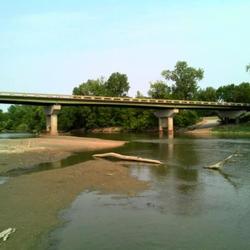Equus Recharge Project
Kansas Water Science Center
The Kansas Water Science Center provides data and research on water availability and ecosystem health in support of Federal, State, and local agencies in Kansas and across the U.S.
News
Kansas Water Science Center Quarterly Newsletter - May 2024
Kansas Water Science Center Quarterly Newsletter - May 2024
Kansas Water Science Center Presents: Science Seminar Series - July 2024
Kansas Water Science Center Presents: Science Seminar Series - July 2024
Kansas Water Science Center Presents: Science Seminar Series - April 2024
Kansas Water Science Center Presents: Science Seminar Series - April 2024
Publications
Methods for computing water-quality concentrations and loads at sites operated by the U.S. Geological Survey Kansas Water Science Center
The U.S. Geological Survey (USGS) Kansas Water Science Center (KSWSC) has published time-series computations of water-quality concentrations and loads based on in situ sensor data since 1995. Water-quality constituent concentrations or densities are computed using regression models that relate in situ sensor values to laboratory analyses of periodically collected samples. These regression models c
Water-quality trends in the Kansas River, Kansas, since enactment of the Clean Water Act, 1972–2020
The Clean Water Act was passed by Congress in 1972 to regulate pollution within the waters of the United States. The U.S. Geological Survey (USGS), in cooperation with the Kansas Department of Health and Environment (KDHE), the Kansas Water Office, the Nature Conservancy, the City of Lawrence, the City of Manhattan, the City of Olathe, the City of Topeka, WaterOne, and Evergy, compiled and analyze
Interdisciplinary science approach for harmful algal blooms (HABs) and algal toxins—A strategic science vision for the U.S. Geological Survey
Executive SummaryAlgal blooms in water, soils, dusts, and the environment have captured national attention because of concerns associated with exposure to algal toxins for humans and animals. Algal blooms naturally occur in all surface-water types and are important primary producers for aquatic ecosystems. However, excessive algae growth can be associated with many harmful effects ranging from aes
By
Ecosystems Mission Area, Water Resources Mission Area, Environmental Health Program, Toxic Substances Hydrology, Earth Resources Observation and Science (EROS) Center , Kansas Water Science Center, National Wildlife Health Center, New Jersey Water Science Center, New York Water Science Center, South Atlantic Water Science Center (SAWSC), Upper Midwest Water Science Center, Landsat Missions
Science
Effect of Water-Injection Dredging (WID) Operations on Water Quality Downstream from Tuttle Creek Reservoir
USGS continuous water-quality monitoring and discrete sampling is an integral component for understanding pre-, during, and post-WID water-quality conditions and the impacts on the surrounding ecosystems.
6PPD-Quinone
6PPD-Q is a compound used to make tires more durable and is also linked to toxicity for Coho Salmon and other aquatic species.
Water-Quality Monitoring in the Lower Kansas River Basin
The Kansas River provides recreational and industrial uses, food procurement, groundwater recharge, irrigation, livestock water use, and drinking water to more than 950,000 people in northeastern Kansas. Water-quality concerns related to excessive chloride, bromide, nutrient, sediment, and bacteria concentrations have been identified by the State, several water suppliers that use the Kansas River...







